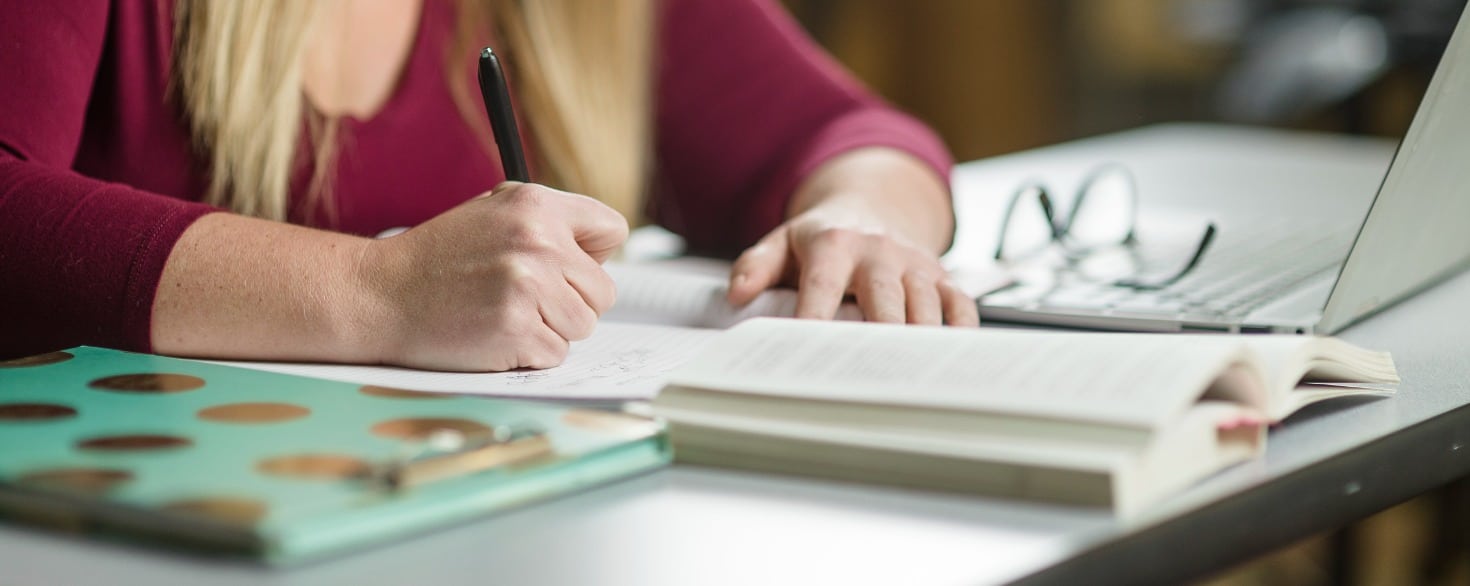
After hours of work, you pull one last sentence out to finish writing that paper. Cross all the t’s, dot all the i’s and you’re good to go.
Or should you be?
Once you include and format that last page of references, you’re just about there. But you also probably have some editing to do.
Don’t let the term “editing” scare you. The “editing process” isn’t just something English majors do with a red pen. Editing allows you to build upon the strengths you’ve already included by removing the distractions that get in the way—like errors in grammar, paragraph structure and word choice.
Like you would look over an account summary, proposal or other organizational document before submitting, so you should review your paper prior to turning it in.
Editing vs. Revising vs. Proofreading
Before you jump in to start making changes, it’s important to distinguish a few steps in the writing process. The processes of editing, proofreading and revising are often used interchangeably, but each step has a different focus.
- Revising: A step distinct from editing that involves writing and re-writing your content. In revising, you often add, rearrange, remove and replace content. Revising has the big picture in mind which your paper is trying to address.
- Proofreading: A practice that is involved in the overall editing process. Proofreading focuses on issues in the paper relating to spelling, grammar, syntax, punctuation and formatting.
- Editing: A step after revising that takes a look at how information is presented in the paper. While this process includes proofreading, it also takes a deeper look into making the paper easier to understand, better organized and tailored to the audience.
Now that we’ve identified what the editing process is, let’s take a look at what basic steps should be included.
1. Read for Structure
You’ve got the content down and have spent time rewriting sections that needed a little boost. Now, it’s time to do some reading.
One of the first times you read through, be intentional about looking for the overall organization, structure and flow of the paper. Imagine yourself as your classmate or instructor. Would they be able to follow your topic easily?
Similar to the revising process, this first read-through of your paper looks at the big picture. Does it accomplish the goals you’ve originally set out to achieve?
Ask yourself key questions such as:
- Does your paper support and contribute to your thesis in your introduction?
- Does the order of your sentences flow smoothly within a paragraph?
- Does the tone of each sentence match the rest of the paper?
- Do your paragraphs flow smoothly and logically with transitions?
- Are your sentences clear and uncluttered?
- Is the tone and style consistent throughout each sentence?
Reading through your paper, whether silently or aloud, with a broader view will help you pick out areas that don’t flow together well.
2. Read for Grammar and Punctuation
Next, look into the details of your paper. This is the part of the editing process you may think of most often—looking at grammar, punctuation, word choice and other nitty-gritty details.
In reading through your paper with your focus on the details, ask questions such as:
- Is everything spelled correctly?
- Are all punctuation marks used accurately?
- Are all your citations formatted correctly?
- Does the vocabulary you use appropriate for the topic?
- Do each of the sentences maintain the appropriate verb tense?
- Do you use too many cliches that cloud your argument?
- Do all sentences maintain parallel structure?
As you write more papers and continue to revisit the editing process, you’ll be able to identify the errors that you tend to make most often. You’ll get a better sense of your tone and style of writing. With practice, this editing process will get easier.
3. Stop Your Working
You’re on a deadline and the next step is to stop working? What?
While it may seem most efficient to power through and move right from writing to revising to all stages of editing, it’s also not the most effective. Stepping away from your paper, whether for a day or just an hour, allows you to revisit the work with a fresh set of eyes.
Here’s what Christopher Melotti said in his LinkedIn post of the importance of taking a break in the editing process:
Through this distance, when you come to edit the writing after a sufficient amount of time, you will be in a far better position to see the flaws and the errors that you would otherwise have missed, simply because at the time of writing, you were too heavily invested.
Allow yourself time to take a break. Doing so will help you reset, refocus and make your next read-through more effective.
4. Read Aloud Once More
If you haven’t read your paper aloud yet, do it. Yes, it might feel silly at first, but reading your paper out loud lets you hear and notice things that you didn’t catch in your first few read throughs. Whether you read it aloud yourself or have someone read it to you, hearing your content gives you a new way of reviewing.
According to a resource provided by the Writing Center at the University of North Carolina at Chapel Hill, reading your work aloud has several benefits:
When you read your draft out loud or listen to someone else read it, your brain gets the information in a new way, and you may notice things that you didn’t see before… Sometimes sentences aren’t grammatically incorrect, but they are still awkward in some way—too long, too convoluted, too repetitive. Problems like these are often easily heard.
So find a quiet room, grab a glass of water and use your ears in this stage of the editing process.
5. Phone a Friend
You’ve written and you’ve read—several times. You may know your thesis by heart now. You could probably condense all the content and tell it as a bedtime story to your child. The next step, while not always necessary but certainly helpful, is having someone else do some of the work. Have a friend, classmate, coworker, mentor read through your paper.
Why is having someone else go through your paper beneficial?
It’s all about getting a fresh set of eyes on the content. Like how you took a break from editing your paper so you could return to it refreshed, so peer review can highlight mistakes you may not have realized.
While peer review can happen at a variety of stages in the editing process—from a rough to a near-final draft—it helps to have done some editing yourself before handing it over. It’ll save time for your reviewer and keep you from frequently blushing about those mistakes you knew were wrong but missed while writing.
Chandra Clarke from Scribendi notes the importance of peer review in her article:
It’s easy to overlook errors when editing your own writing because your brain automatically fills in the blanks of what you meant to say. An editor other than yourself can help you determine when your writing doesn’t clearly express your ideas.
Have your friend ask similar questions you’ve asked yourself during your revision and editing processes. Be sure to include both big picture and detailed questions, such as:
- Big Picture:
- What is the author’s main point in the paper?
- Do each of the main points have sufficient support?
- Is the paper easy to follow and understand?
- Details:
- Are there any errors in grammar?
- Are there any errors in punctuation?
- Are there any errors in APA Style?
Don’t be discouraged if your friend suggests a lot of changes or improvements. They want to see you succeed in your work and are trying to help you become a better writer. And, keep in mind that not all of their suggestions may be accurate or applicable.
6. Review and Release
After you’ve reviewed the changes suggested by your friend, read through it one last time. Double-check your citations. Be confident in your word choices and paragraph breaks.
Once you’re done reviewing and making the edits you need to, be done. Especially if you tend to be a perfectionist in your work, get to that point with your paper when you’ve written, reviewed and edited at your best.
Sure, you could continue to obsess over that one phrase on the second page in the third paragraph. Or, you could be confident that you’ve worked hard on your assignment and tried your best.
Editing That Makes Your Paper Better
The whole editing process isn’t implemented so you can be discouraged by your writing mistakes. It’s a way to build upon the great content you’ve already written and help other readers understand and learn from that quality writing.
With these six steps of reading for structure, reading for details, taking a break, reading aloud, peer review and feeling confident in your paper, you can submit an assignment of high quality that could earn high grades and help you become a better writer. Sure, it takes more time than just writing one draft and being done with it. But pursuing your personal and professional goals is worth the work.
Be Supported as You Pursue Your Goals
PGS offers numerous Academic Support resources to equip you to succeed in your degree program, whether that’s in writing a paper or other assignment. Visit our academic support webpage to discover more essential tools.








